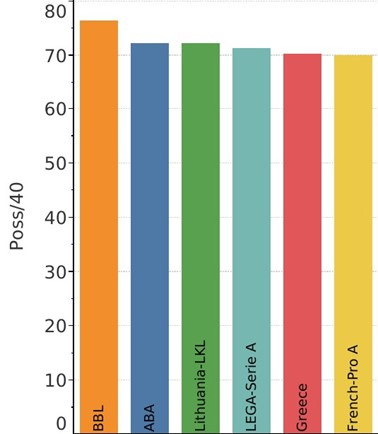In the world of basketball, the pace of play is a defining characteristic that varies significantly from league to league. Each league has its own unique rhythm, shaped by its history, culture, and basketball philosophy. These differences can make certain leagues more appealing to some players while less so to others. Consequently, it is essential for player representation agencies and basketball teams to consider whether a player fits well with the playing style and pace of the league they are entering. This post delves into the analysis of six different leagues (season 2023-24), examining the pace of play and its implications for both teams and players.
BBL (British Basketball League)
ABA (Adriatic Basketball Association)
LEGA-Serie A (Lega Basket Serie A)
Lithuania-LKL (LKL - Lithuanian Basketball League)
Greece (Greek Basket League)
French-Pro A (French Pro A League)

Comparing the Pace Across Leagues
In Figure 1, we can see a comparative analysis of the pace of play across six different basketball leagues. The metric used for comparison is the number of possessions per 40 minutes (Poss/40), which provides a standardized measure of how fast or slow the game is played in each league.
BBL is the league with the highest pace among the analyzed leagues, indicating a faster style of play with more possessions per game. The difference compared to the second-highest pace league is considerable.
On the opposite side of the chart are the Greek league and the French Pro A with low playing paces, indicating a more tactical and slower game.
Analyzing Team Paces
In this part, we will provide a more granular look at the pace of individual teams within these leagues.
Teams with Higher Poss/40
Figure 2 showcases teams that play at a higher pace, meaning they have more possessions per 40 minutes. Teams like the London Lions or Newcastle Eagles from the BBL feature prominently here, highlighting the league’s overall fast pace. These teams prefer quick transitions and a high-energy game, which can be demanding but also exciting for players who thrive in such environments. Eight of the ten teams on this list are from BBL.
Teams with Lower Poss/40
Figure 3 focuses on teams that play at a slower pace. Teams like Gravelines-Dunkerque or Saint-Quentin (from the PRO A) are examples of those that prioritize careful, strategic play and solid defensive structures. This slower pace can be more suitable for players who excel in half-court settings and tactical gameplay. The chart of teams that play at a slower pace highlights the French and Greek teams.
Notably, in both Figures 2 and 3, at least one team from the LEGA appears. This indicates that it is a league with significant contrasts, featuring teams at both ends of the pace spectrum.
Implications for Clubs and Player Representation Agencies
Understanding the pace of play is critical not only for basketball clubs looking to recruit new talent but also for player representation agencies aiming to place their clients in the best possible environments.
For Clubs:
- Scouting and Recruitment: Clubs need to align their recruitment strategies with their playing style. A fast-paced team might not benefit as much from a player who thrives in slower, more tactical settings, and vice versa.
- Training and Adaptation: Once a player is recruited, ensuring they can adapt to the team's pace is essential. This may involve specific conditioning programs and tactical training.
For Player Representation Agencies:
- Player Assessment: Agencies should evaluate not only the technical skills of their clients but also their ability to adapt to different paces of play. This can involve analyzing past performance metrics and understanding the player’s comfort zone.
- Targeted Placement: By understanding the pace of the destination leagues and teams, agencies can make more informed decisions about where to place their players, maximizing their chances for success and career growth.
Conclusion
The pace of play is a vital aspect of basketball that significantly influences both team dynamics and individual player performance. As we have seen from the analysis of six different leagues and their respective teams, there are notable differences in how fast or slow the game is played. For clubs, understanding these differences is key to effective scouting and recruitment. For player representation agencies, it is crucial to consider these factors when placing players to ensure they can thrive in their new environments.
By paying close attention to the pace of play, both teams and player agencies can make more strategic decisions that lead to better outcomes on the court. This holistic approach not only enhances the player's career but also contributes to the overall success and competitiveness of the teams and leagues involved.
This is just a brief analysis considering the pace of play, but teams and player representation agencies should conduct this type of analysis with other metrics as well, to make better decisions.
At Basketball Analytics Lab, we offer data analytics services to clubs, enabling them to enhance their performance without significantly increasing their budgets.
Feel free to share and comment if you found this article interesting.
Where Data Meets the Hoops - Let's Analyse the Game Together!





